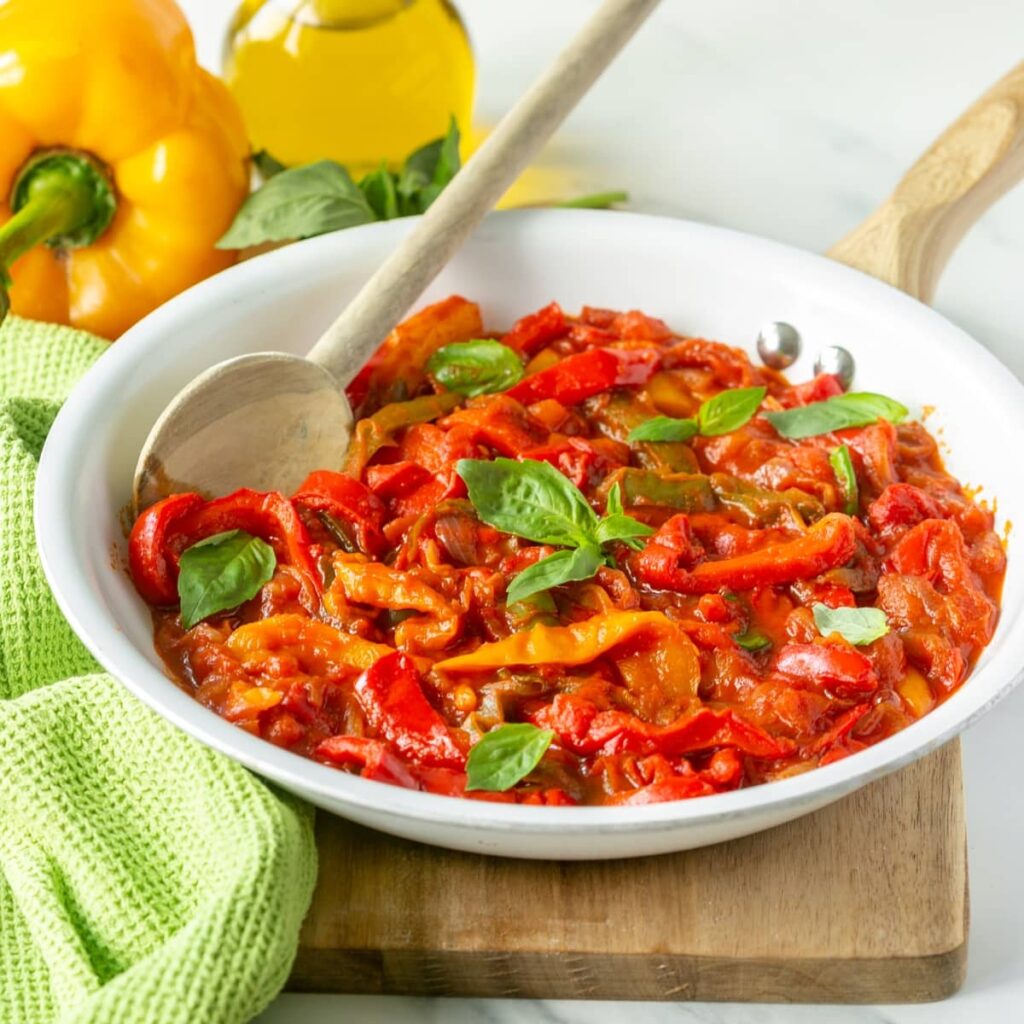Discover the vibrant flavors of peperonata – This classic Italian sweet peppers recipe is a fantastic veggie side dish for any occasion.
Peperonata is one of the most classic Italian side dishes. Simple and colorful, it features sweet peppers , onion and tomato, and pairs perfectly with meat or fish main courses.
You can also serve it with a platter of mixed cheeses and cured meats, for an irresistible Italian aperitivo platter.
Growing up in Italy, I’ve seen many different versions of peperonata, but today I’m sharing with you the Sicilian version, which is the clear winner for me.
Of course, you can use it as a base and then add some extra ingredients such as olives or potatoes.
The beauty of this dish is that it calls for a few simple inexpensive ingredients, and it’s a super easy and satisfying veggie side dish.
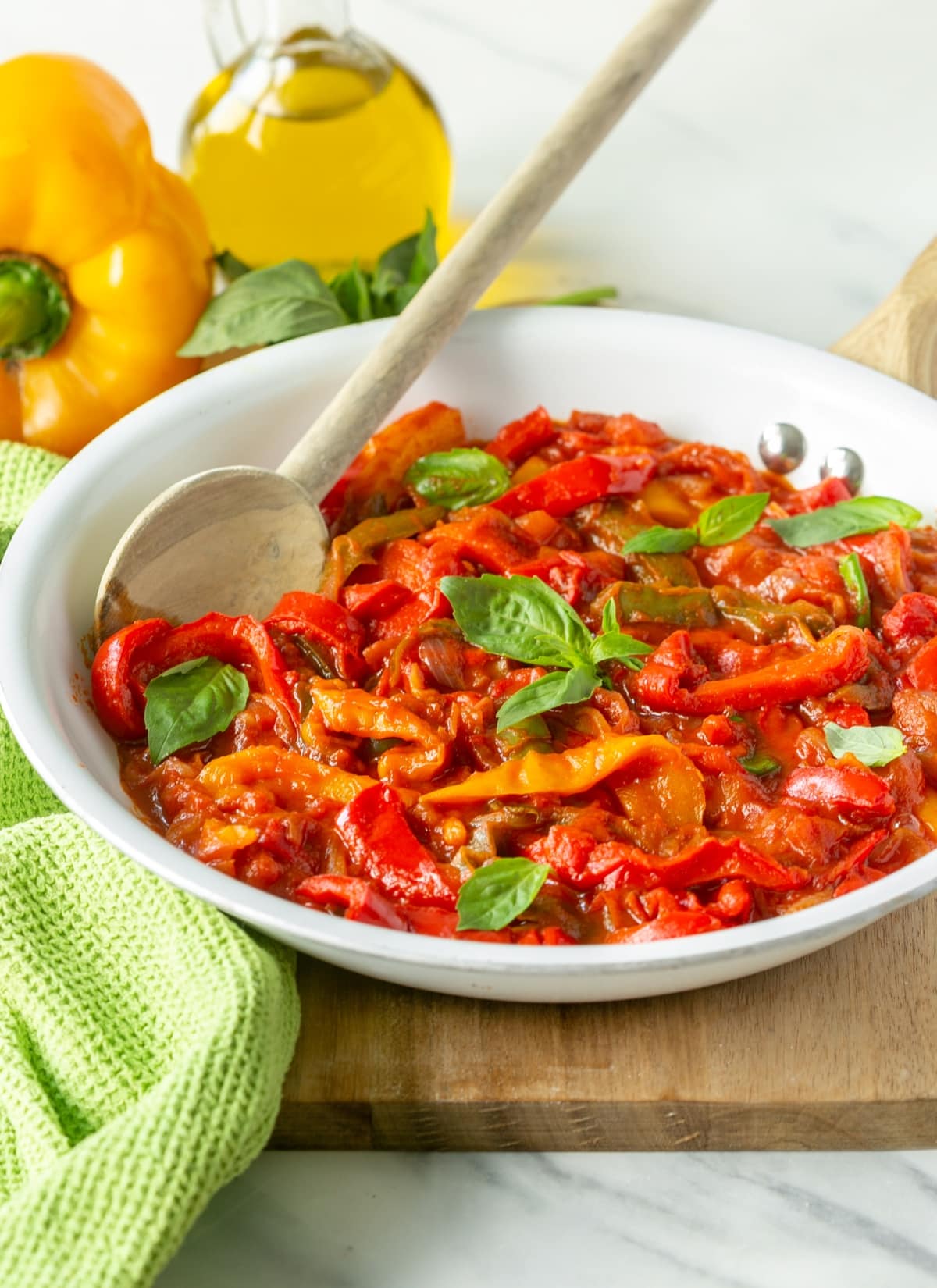

Peperonata can be served either hot or cold, making it perfect for enjoying leftovers over several days or satisfying a large and hungry crowd.
As a bonus, this popular sweet Italian peppers recipe is naturally dairy-free, gluten-free and vegan, making it a fantastic option to serve at dinner parties and get-togethers.
Jump to:
What is peperonata?
Peperonata comes from the Italian word “peperoni” which means bell peppers.
This sweet Italian peppers stew, similar to the French ratatouille, is one of the most popular side dishes, together with parmigiana and caponata .
The original recipe features peppers, onions tomatoes, and basil, but there are endless and equally popular regional variations.
The Sicilian version differs from all the others due to the addition of vinegar and sugar which give the peperonata an irresistible sweet and sour taste.
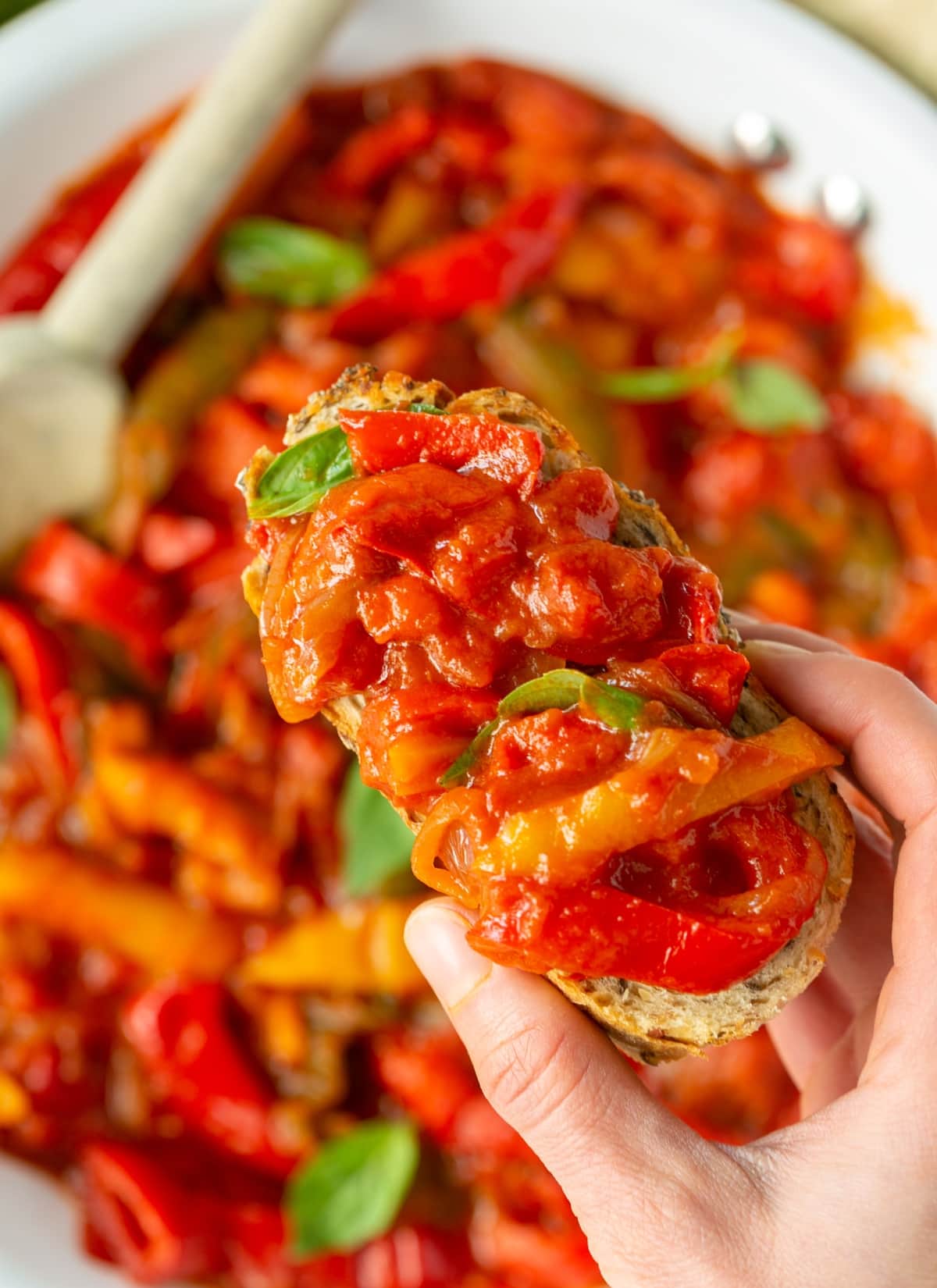

Peperonata recipe ingredients
This delicious sweet Italian peppers dish is incredibly easy to make, and all you need is less than 10 ingredients:
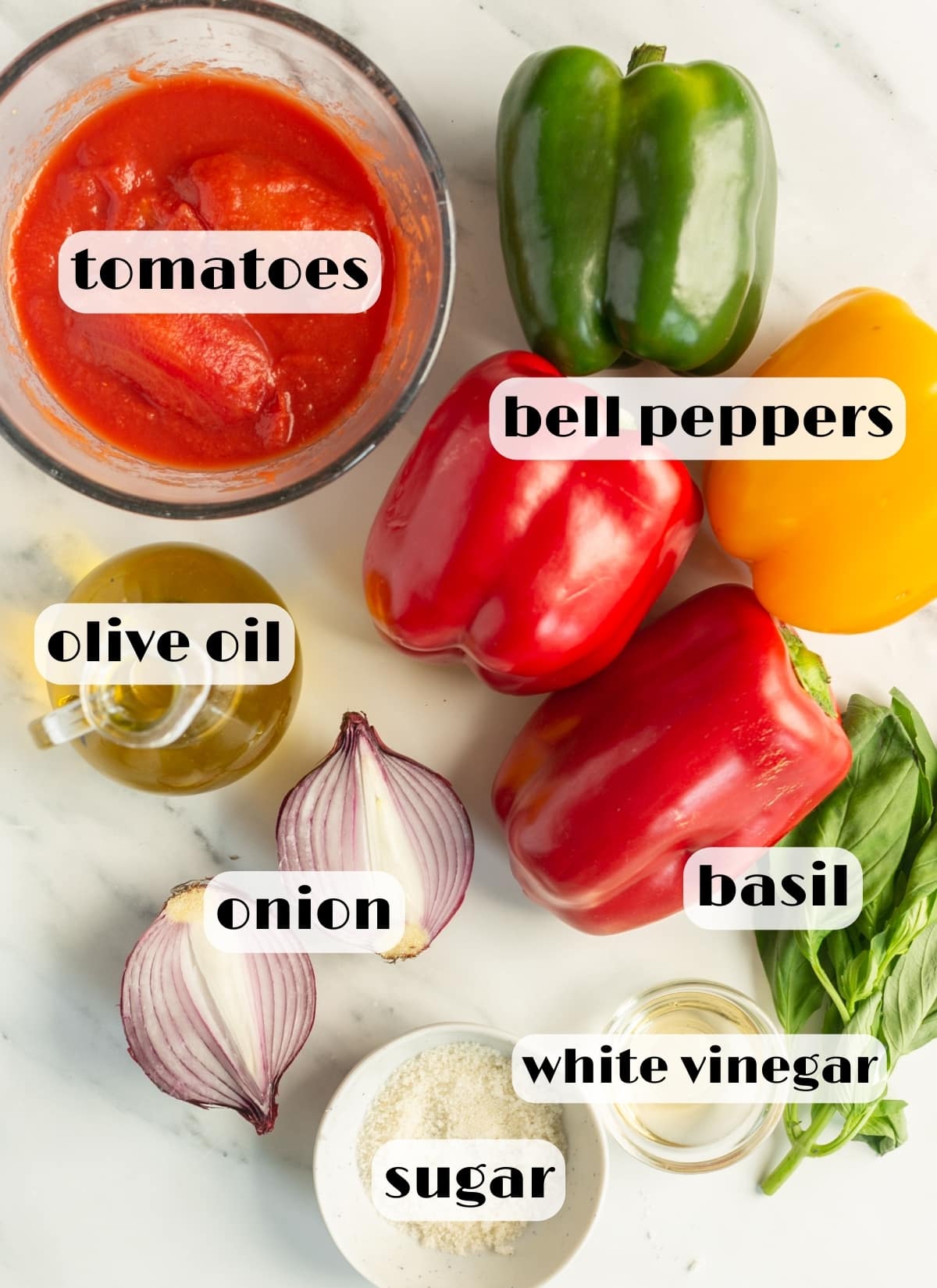

- Bell peppers: To make a great peperonata it is essential to use all 3 colors (green, yellow and red ) because they have different flavors and textures
- Tomatoes: You can use peeled ripe San Marzano tomatoes, canned whole tomatoes or tomato passata.
- Vinegar: you’ll need white wine vinegar for this recipe.
- Sugar: You can use granulated sugar or raw cane sugar.
- Basil: fresh basil leaves add a wonderful aromatic note. You can also substitute it with fresh mint leaves or oregano.
- Extra-virgin olive oil: Use high-quality, lightly fruity extra-virgin olive oil for best results.
You can omit the tomatoes to serve the peperonata as a side dish, or to add to sandwiches. Add the canned tomatoes and their juice if you want to make peperonata sauce to serve with pasta or if you want it a bit more “saucy”.
Extra ingredients
There are different variations, depending on the Italian region in which it is made. Here below are some suggestions:
- Potatoes: Add small cubed potatoes and let them cook together with the peppers.
- Olives: Once the dish is ready, add black olives (kalamata olives are a great option) or green olives of your choice (Nocellara olives are my go-to)
- Eggplant: The Calabrian version (and some part of Sicily) calls for cubed eggplant, stir-fried separately and then added to the final dish.
- Garlic: Add two garlic cloves while cooking the peppers, then discard before serving.
How to make peperonata
This Italian sweet pepper recipe is very easy to make and comes together in less than hour.
Here’s a quick recipe overview with step-by-step pictures.
Scroll until the end of the post for the full printable recipe.
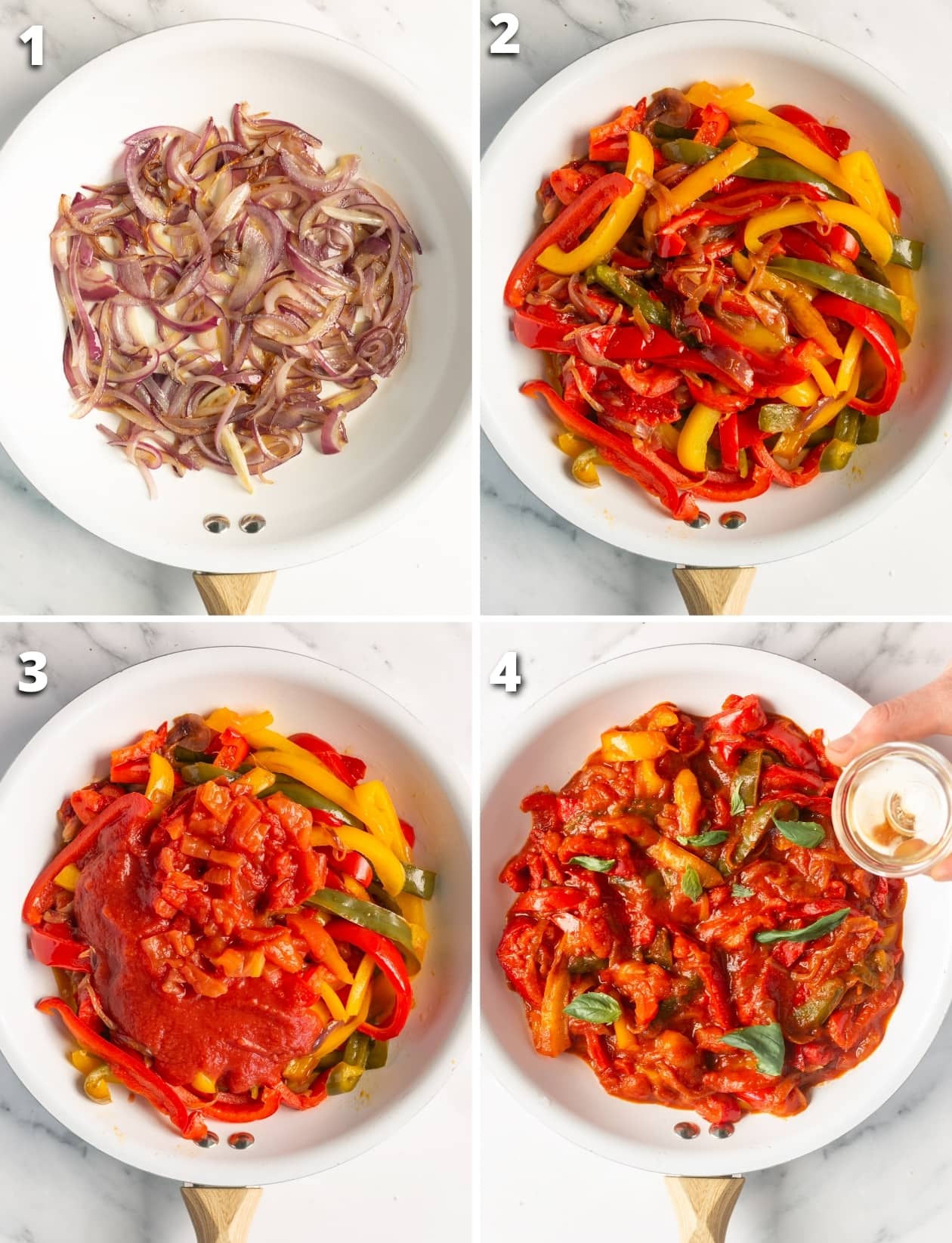

STEP 1. Place the sliced onion in a pan with extra virgin olive oil and soften over medium heat.
STEP 2. Add the sliced peppers and stir fry for 2 minutes, then cover and cook over low heat for 10 minutes.
STEP 3. Add chopped canned tomatoes and their juice (optional), basil, and a ladle of warm water, cover and cook for 20 minutes.
STEP 4. Pour in the vinegar and sugar, season to taste, cook for 2 minutes on high heat, then remove the pan from the heat. Add more fresh basil and serve straight away or at room temperature.
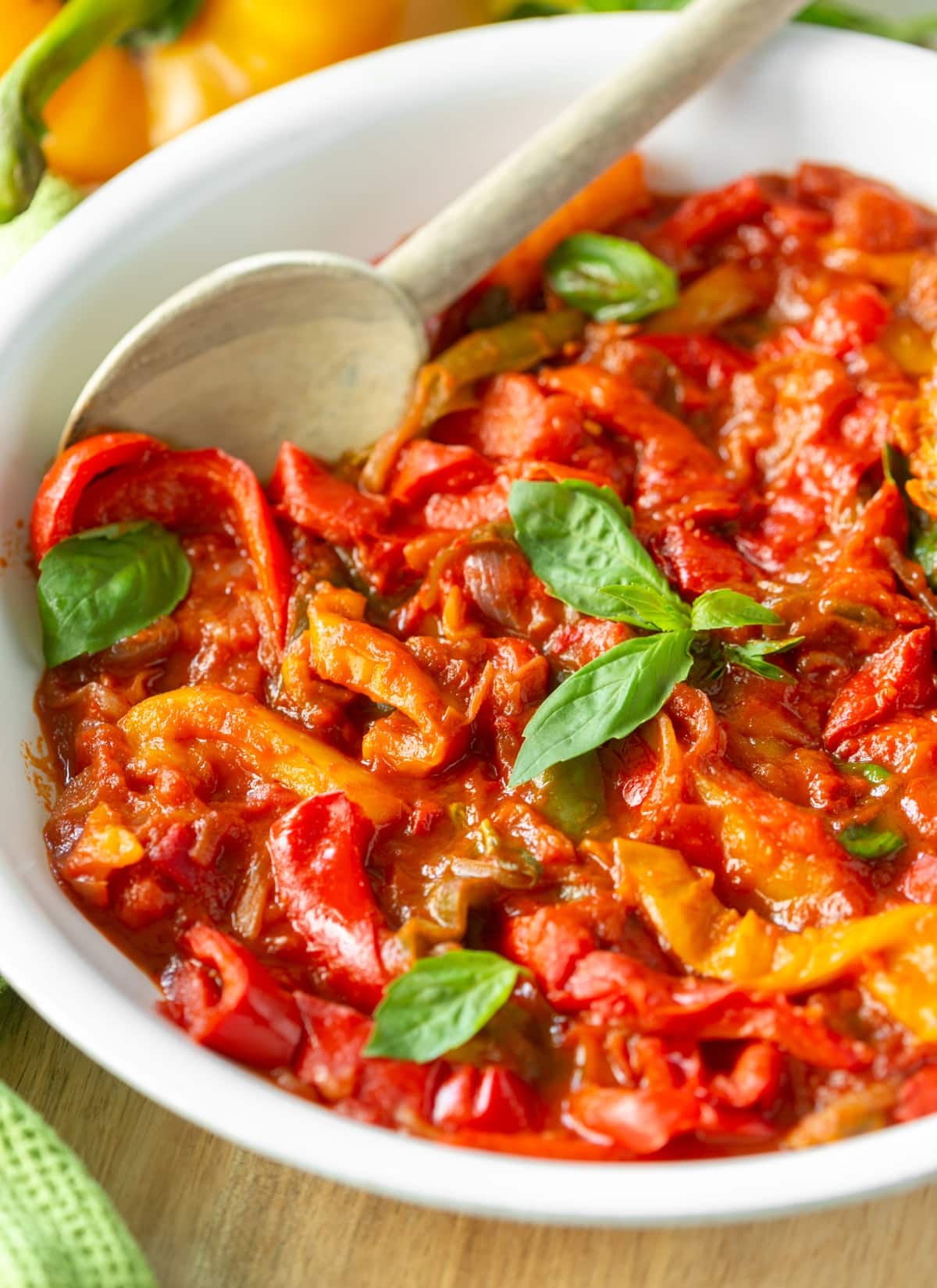

Storage tips
Peperonata is one of those dishes that tastes even better the next day.
Store it in an airtight container, and refrigerate for up to 3 days.
You can also freeze it for up to 1 month, and thaw in the refrigerator overnight before use.
What to serve with peperonata
Peperonata pairs wonderfully with a variety of dishes. Here are some options:
- Pasta: Toss it with cooked pasta to make peperonata pasta, a fantastic vegan meal you can serve both hot and cold!
- Fish and meat: Serve as a side dish for grilled fish, chicken cutlets or veal milanese.
- Bruschetta: Serve on top of crusty grilled bread for the perfect bruschetta.
- Aperitivo: Serve with an aperitivo board with cheeses, prosciutto, olives and crostini.
- Eggs: Top scrambled or fried eggs with peperonata for a flavorful breakfast or brunch option.
- Sandwiches: Use it as a condiment or filling for sandwiches, wraps, or paninis for a tasty lunch option.
- Polenta: Spread it over creamy polenta for a comforting and rustic Italian meal.
More veggie side dishes recipes
If you’re looking for more ways to incorporate vegetables into your meals with delicious recipes, here are some suggestions I have for you:
Did You Try This Recipe?
Please let me know how you liked it! Leave a comment below and share a picture on Instagram with the hashtag #thepetitecook!
Don’t forget to subscribe to my newsletter and follow along on Facebook, Pinterest and Instagram for all of the latest updates
Recipe
Prevent your screen from going dark
Discover the vibrant flavors of peperonata – This classic Italian sweet peppers recipe is a fantastic veggie side dish for any occasion.
Serving: 4
Calories: 192kcal
Ingredients
- 4 mixed bell peppers, see notes*
- handful fresh basil leaves
- 1 14.5 oz canned tomatoes, see notes*
- 1 medium red onion
- 4 tablespoon extra-virgin olive oil
- 4 tablespoon white vinegar
- 2 tablespoon sugar
- sea salt and freshly-cracked black pepper
Instructions
-
Place the sliced onion in a pan with the extra virgin olive oil and soften over medium heat, being careful to lower the heat as soon as the onion browns.
-
Add the sliced peppers and stir fry them for 2 minutes, then cover the pan with a lid and cook over medium-low heat for 10 minutes.
-
Add the chopped canned tomatoes and their juice (optional), a few basil leaves and a ladle of warm water. Cover the pan with a lid, and cook over medium-low heat for 20 minutes.
-
Pour in the vinegar and sugar, season to taste, and cook all the ingredients for 2 minutes on high heat, to let the vinegar evaporate.
-
Remove the pan from the heat and transfer the peperonata to a serving plate. Top with more fresh basil and serve straight away or at room temperature.
Notes
- Peel: This is optional, but if you like you can peel the bell pepper skin off with a potato peeler.
- Cut off the top: Use a sharp knife to slice off the stem end of the pepper. This will create a flat surface for easier slicing.
- Remove the core and seeds: Cut the pepper in half horizontally, and remove the core, seeds and white membrane.
- Slice the pepper: Once the core and seeds are removed, lay the pepper flat on the cutting board and cut into strips.
How to prepare the tomatoes:
- Canned tomatoes: half them horizontally, and discard their seeds and juice, then cut them into cubes. Feel free to add the canned juices for a more saucy peperonata.
- Fresh tomatoes: blanch the tomatoes by immersing them in boiling water for about 30 seconds, then peel the skin off, discard their seeds and juice, and cut them into cubes.
How to store peperonata:
This is one of those dishes that tastes even better the next day.
Store leftovers in an airtight container, and refrigerate for up to 3 days.
You can also freeze it for up to 1 month, and thaw it in the refrigerator overnight before use.
Nutrition
Calories: 192kcal | Carbohydrates: 16g | Protein: 1g | Fat: 14g | Saturated Fat: 2g | Polyunsaturated Fat: 2g | Monounsaturated Fat: 10g | Sodium: 7mg | Potassium: 293mg | Fiber: 3g | Sugar: 12g | Vitamin A: 3727IU | Vitamin C: 154mg | Calcium: 16mg | Iron: 1mg
The information shown is an estimate provided by an online nutrition calculator. It should not be considered a substitute for a professional nutritionist’s advice.



